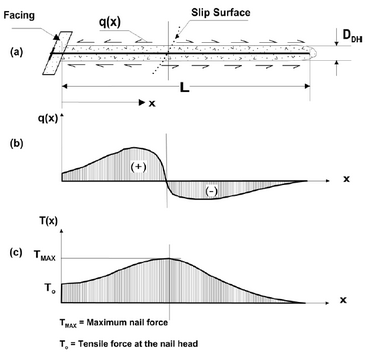Introduction
Soil Nailing is a technique for supporting slopes and excavation faces by introducing reinforcing elements (nails) into the soil, typically consisting of metal bars. The reinforcements are passive elements that contribute to the stability of the system primarily in tension due to the deformations of the supported soil. They transfer the tensile forces to the surrounding soil through shear forces along the reinforcement-soil interface, as illustrated in Figure 1.

Fig. 1 – Stress transfer mechanism at the reinforcement-soil interface (American guidelines FHWA-NHI-14-007).
This technique can be employed for reinforcing existing slopes as well as stabilizing excavation faces. In the latter case, the "top-down" technique is used for implementation, which can be summarized schematically in the following steps:
•Excavation of the first level where the intervention will take place;
•Drilling of holes;
•Insertion of reinforcements into the holes;
•Placement of synthetic drainage mats and the initial layer of the lining (e.g., shotcrete);
•Repetition of the previous steps until reaching the final excavation depth;
•Completion of the intervention: final layer of the lining and tightening of the anchorages.
Consequently, the main elements of a Soil Nailing wall, studied in the design phase, are:
•The soil;
•The reinforcements;
•The lining.